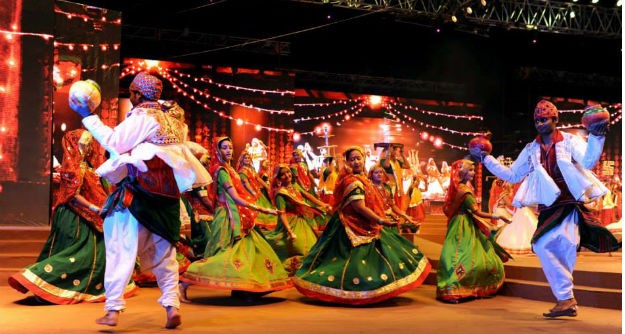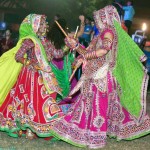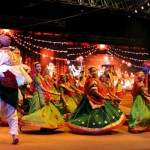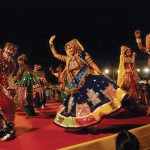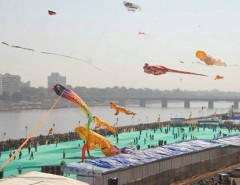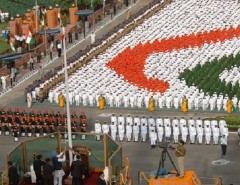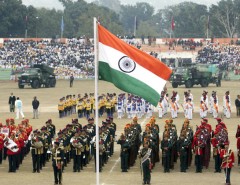Navaratri (Sanskrit: नवरात्रि) is a festival dedicated to the worship of the Hindu deity Durga. The word Navratri means ‘nine nights’ in Sanskrit, nava meaning nine and ratri meaning nights. During these nine nights and ten days, nine forms of Devi are worshipped. The tenth day is commonly referred to as Vijayadashami or “Dussehra” (also spelled Dasera). Navaratri is an important major festival and is celebrated all over India and Nepal. Diwali the festival of lights is celebrated twenty days after Dasera. Though there are in total five types of Navaratri that come in a year, Sharada Navaratri is the most popular one. Hence, the term Navaratri is being used for Sharada Navaratri.
Traditions of Navaratri
Navaratri is celebrated five times a year. They are Vasanta Navaratri, Ashadha Navaratri, the Sharada Navaratri, the Pausha/Magha Navaratri and the Magha Navaratri. Of these, the Sharada Navaratri of the month of Puratashi and the Vasanta Navaratri of the Vasanta kala are the most important. The other two are observed by shaktas only.
- Vasanta Navaratri: Vasanta Navaratri, its nine days are dedicated to the nine forms of Shakti (Mother Goddess) in the month of Chaitra (March–April) and is observed during the Shukla Paksha (waxing phase of moon) of Chaitra. The beginning of this Navaratri also marks the start of the new year as per the Hindu mythological lunar calendar (Vikrami Samvata).
- Ashada Navaratri : Ashada Navaratri, also referred to as Gupta, Gayatri or Shakambhari Navaratri, is nine days dedicated to the nine forms of Shakti (Mother Goddess) in the month of Ashadha (June–July). It is observed during the Ashadha Shukla Paksha (waxing phase of moon). This is mostly observed by shaktas only
- Sharada Navaratri: This is the most important of the Navaratris. It is simply called Maha Navaratri (the Great Navaratri) and is celebrated in the ‘pratipada’ (first day) of the bright fortnight of the lunar month of Ashvini. Also known as Sharada Navaratri, as it is celebrated during Sharada (beginning of winter, September–October).
- Pausha Navaratri: Pausha Navaratri is observed during the Pausha Shukla Paksha, the waxing phase of moon, in the month of December–January.
- Magha Navaratri: The Magha Navaratri is also a kind of Gupta Navaratri. The waxing phase of moon in January–February marks the beginning of Magha Navaratri.
Vasanta Navaratri
This is celebrated during Vasanta Rhitu (beginning of spring) (March – April). This is also known as Chaitra navarathri as it falls during the lunar month of Chaitra.
The Story of Vasanta Navaratri In days long gone by, King Dooshibago was killed by a lion when he went out hunting. Preparations were made to crown the prince Sudarsana. But, King Yudhajita of Ujjain, the father of Queen Lilavati, and King Virasena of Kalinga, the father of Queen Manorama, were each desirous of securing the Kosala throne for their respective grandsons. They fought with each other. King Virasena was killed in the battle. Manorama fled to the forest with Prince Sudarsana and a eunuch. They took refuge in the hermitage of Rishi Bharadwaja.
The victor, King Yudhajita, thereupon crowned his grandson, Satrujita, at Ayodhya, the capital of Kosala. He then went out in search of Manorama and her son. The Rishi said that he would not give up those who had sought protection under him. Yudhajit became furious. He wanted to attack the Rishi. But, his minister told him about the truth of the Rishi’s statement. Yudhajita returned to his capital.
Fortune smiled on Prince Sudarsana. A hermit’s son came one day and called the eunuch by his Sanskrit name Kleeba. The prince caught the first syllable Kli and began to pronounce it as Kleema. This syllable happened to be a powerful, sacred Mantra. It is the Bija Akshara (root syllable) of the Divine Mother. The Prince obtained peace of mind and the Grace of the Divine Mother by the repeated utterance of this syllable. Devi appeared to him, blessed him and granted him divine weapons and an inexhaustible quiver. The emissaries of the king of Benares passed through the Ashrama of the Rishi and, when they saw the noble prince Sudarsana, they recommended him to Princess Sashikala, the daughter of the king of Benares.
The ceremony at which the princess was to choose her spouse was arranged. Sashikala at once chose Sudarsana. They were duly wedded. King Yudhajita, who had been present at the function, began to fight with the king of Benares. Devi helped Sudarsana and his father-in-law. Yudhajita mocked Her, upon which Devi promptly reduced Yudhajita and his army to ashes. Thus Sudarsana, with his wife and his father-in-law, praised Devi. She was highly pleased and ordered them to worship her with havana and other means during the Vasanta Navarathri. Then she disappeared.
Prince Sudarsana and Sashikala returned to the Ashram of Rishi Bharadwaja. The great Rishi blessed them and crowned Sudarsana as the king of Kosala. Sudarsana and Sashikala and the king of Benares implicitly carried out the commands of the Divine Mother and performed worship in a splendid manner during the Vasanta Navarathri. Sudarsana’s descendants Sri Rama and Lakshmana also performed worship of Devi during the Sharad Navarathri and were blessed with Her assistance in the recovery of Sita.
According to the Krittibas Ramayana, Rama invoked the goddess Durga in his epic battle against Ravana. Although Goddess Durga was traditionally worshipped in the late spring, due to contingencies of battle, Lord Rama had to invoke her in the form of astama (eighth) Mahavidya (Maa Bagla) in the autumn and thus is known as akaala bodhana (invoking out of scheduled time). This autumnal ritual was different from the conventional Durga Puja, which is usually celebrated in the springtime. So, this Puja is also known as ‘akala-bodhana’ or out-of-season (‘akala’) worship (‘bodhana’). This Rama’s date for the Navaratri puja has now gained ascendancy and culminates with Dusherra in North India on the following day.
Shardiya Navaratri
Shardiya Navaratri is the most popular and significant Navaratri of all Navaratris. That’s why Shardiya Navaratri is also known as Maha Navaratri.
It falls in lunar month Ashwini during Sharada Ritu. The name Shardiya Navaratri has been taken from Sharada Ritu. All nine days during Navaratri are dedicated to nine forms of Goddess Shakti. Shardiya Navaratri falls in the month of September or October. The nine days festivity culminates on tenth day with Dussehra or Vijayadashami.
Forms of Shakti
Nine forms of Shakti are worshipped during the Navaratris. The Devis worshipped depend on the tradition of the region.
- Durga
- Kali
- Amba or Jagadamba, Mother of the universe
- Annapoorna devi or Mahagauri, The one who bestows grains (anna) in plenty (purna: used as subjective)
- Sarvamangala or Shitala, The one who gives happiness (mangala) to all (sarva)
- Bhairavi
- Chandika or Chandi, The one who killed a demon named Chanda.
- Lalita
- Bhavani
- Mookambika or Tara
Rituals
The Sharada Navratri commences on the first day (pratipada) of the bright fortnight of the lunar month of Ashvini. The festival is celebrated for nine nights once every year during the beginning of October, although as the dates of the festival are determined according to the lunar calendar, the festival may be held for a day more or a day less.
Navaratri is celebrated in different ways throughout India. In North India, all three Navaratris are celebrated with much fervor by fasting on all nine days and worshiping the Mother Goddess in her different forms. The Chaitra Navaratri culminates in Rama Navami and the Sharada Navaratri culminates in Durga Puja and Dussehra. The Dussehra of Kullu in Himachal Pradesh is particularly famous in the North. Navaratri festival in Gujarat is one of the main festivals. Garba is a dance which people perform on all nine nights, after the Durga Pooja, in groups accompanied by live orchestra or devotional songs.
The last four days of Sharada Navaratri take on a particularly dramatic form in the state of West Bengal in eastern India where they are celebrated as Durga Puja. This is the biggest festival of the year in this state. Exquisitely crafted and decorated life-size clay idols of the Goddess Durga depicting her slaying the demon Mahishasura are set up in temples and other places. These idols are then worshiped for five days and immersed in the river on the fifth day.In the Punjab, Navaratri is known as Navratras or Naratey where the first seven days are for fasting. On the eighth day or Ashtami, devotees break their fasts by calling young girls home and these girls are treated as the goddess herself. They are called “Kanjak Devis”. People ceremonially wash their feet, worship them and then offer food to the “girl-goddesses” giving them the traditional puri, halwa and chana to eat along with bangles and the red chunnis (scarves) to wear with a token amount of money as “shagun”. The ninth day is then called Navami which means literally the ninth day of this holy and pious period.
Another prevalent practice is of sowing pulses, cereals and other seeds on the first day of this festival in a pot which is watered for nine days at the end of which the seeds sprout. This pot is worshipped throughout the nine days. This custom is also indicative of fertility worship and is known as “Khetri”. The barley grains planted on the first day of Navaratras, in the puja room of the house, are submerged in water after saying prayers on Dussehra. The sowing and reaping of barley is symbolic of the “first fruit”. In Western India, particularly in the state of Gujarat and Maharashtra, Navaratri is celebrated with the famous Garba and Dandiya Raas dance. Since the past few years, the Government of Gujarat has been organising the “Navaratri Festival Celebrations” on a regular basis for the nine days of Navaratri Festival in Gujarat. People from all over Gujarat and even abroad come to participate in the nine-day celebration. It is also popular throughout India and among Indian communities around the world including the UK, Canada, Malaysia, Singapore and USA.
In the temples of Goa, on the first day of the seventh month of the Hindu calendar Ashwini, in temples (and some households), a copper pitcher is installed surrounded by clay in which nine varieties of food grains are sown inside the sanctum sanctorum of the temple. All the nine nights are celebrated by presenting devotional songs, and through religious discourses. Later in the night the idol of the goddess is put in a specially-decorated colourful swing,known as Makhar in Konkani and for nine nights, this swing is being swung to the tune of temple music (called as ranavadya) by devotees who throng in large numbers to participate in the festival.This spectacular ritual accompanied by an orchestra of musical instrument and waving of lamps is called Makharotsav.
In Maharashtra, on the first day of month of Ashwini, Ghatasthapana is celebrated. An earthen pot is filled with water surrounded by clay in which foodgrains are sown and are allowed to sprout for nine days. Five stems of jowar are also placed over the pot. This arrangement is called the “Ghat”. The ladies worship the pot for nine days by offering rituals and a garland of flowers, leaves, fruits, dry-fruits, etc. with a naivedya, and water is offered in order to get the seeds sprouted. Some families also celebrate Kaali pujan on days 1 and 2, Laxmi pujan on days 3, 4, 5 and Saraswati puja on days 6, 7, 8, 9 along with Ghatasthapana. On the eighth day, a “Yajna” or “Hom” is performed in the name of Goddess Durga. On ninth day, the Ghat puja is done and the Ghat is dissolved after taking off the sprouted leaves of the grains.
In many families, a woman from Matang community is called and offered food and blessings are sought from her. She is considered as a form of the Goddess “Matangi”. This process is called “पात्रं भरणे” in Marathi. On the occasion of Dasara or Vijayadashmi, the men go to the forest or farm and bring the leaves of the tree Apta. They worship iron in the form of utensils, weapons, etc. The iron equipments are washed and offered leaves of Apta called gold or “sona” and also leaves of the grains which were sprouted. On this day, a process called Vidyarambhan meaning beginning of learning takes place when small children are to write first alphabet.
In Tamil Nadu, people set up steps and place idols on them. This is known as golu. Photos of typical golu displayed in Tamil Nadu style can be found here.In the evening women in neighborhood invite each other to visit their homes to view Kolu displays, they exchange gifts and sweets. Kuthuvilakku lamp is lit, in the middle of a decorated Rangoli, devotional hymns and shlokas are chanted. After performing the puja, the food items that have been prepared are offered to the Goddess and then to the guests.On the 9th day Saraswati Puja, special pujas are offered to Goddess Saraswati, the divine source of wisdom and enlightenment. Books and musical instruments are placed in the puja and worshipped as a source of knowledge Ayudha Pooja, the worship of vehicles and instruments is the most important festival celebrated in
Tamil Nadu on Navami day .Almost all mechanic shops, heavy industries celebrate ayudha Pooja to thank their instruments On this day one can see autos decorated with banana leaves and pumpkins broken.The 10th day, Vijayadasami – is the most auspicious day of all. It was the day on which evil was finally destroyed by good. It marks a new and prosperous beginning. New ventures started on this day are believed to flourish and bring prosperity. Kids often start tutoring on this day to have a head start in their education.
In the evening of “Vijayadasami”, any one doll from the “Kolu” is symbolically put to sleep and the Kalasa is moved a bit towards North to mark the end of that year’s Navaratri Kolu. Prayers are offered to thank God for the successful completion of that year’s Kolu and with a hope of a successful one the next year. Then the Kolu is dismantled and packed up for the next year. In temples of Tamil Nadu, navaratri is celebrated for the Devi’s dwelling in each temples, The utsava murthy is decorated and vedic offerings are performed, Following by Chandi homa. Popular Tamil Nadu temples celebrating navaratri are Madurai madurai meenakshi temple, Chennai kapaleeswarar temple, Kulasekarapattinam devi temple, Perambur Ellaiamman temple, Srirangam Ranganathan temple.
In Karnataka, Ayudha Puja, the ninth day of Mysore Dasara, is celebrated with the worship of implements used in daily life such as computers, books, vehicles, or kitchen tools. The effort to see the divine in the tools and objects one uses in daily life is central to this celebration, so it includes all tools that help one earn one’s livelihood. Knowledge workers go for books, pen or computers, farmers go for the plough and other agricultural tools, machinery for industrialists and cars/buses/trucks for the transportation workers—all are decorated with flowers and worshiped on this day invoking God’s blessing for success in coming years. It is believed that any new venture such as starting of business or purchasing of new household items on this day is bound to bring success and prosperity.
Mysore is well known for the festivities that take place during the period of Dasara, the state festival of Karnataka. The Dasara festivities, which are celebrated over a ten-day period, it made official festival of the state by King Raja Wodeyar I in 1610. On the ninth day of Dasara, called Mahanavami, the royal sword is worshipped and is taken on a procession of decorated elephants, camels and horses. On the tenth day, called Vijayadashami, the traditional Dasara procession (locally known as Jumboo Savari) is held on the streets of Mysore. An image of the Goddess Chamundeshwari is placed on a golden howdah on the back of a decorated elephant and taken on a procession, accompanied by tableaux, dance groups, music bands, decorated elephants, horses and camels. The procession starts from the Mysore Palace and culminates at a place called Bannimantapa, where the banni tree (Prosopis spicigera) is worshipped. The Dasara festivities culminate on the night of Vijayadashami with a torchlight parade, known locally as Panjina Kavayatthu.
In Kerala and in some parts of Karnataka three days: Ashtami, Navami, and Vijaya Dashami of Sharada Navarathri are celebrated as Sarasvati Puja in which books are worshiped. The books are placed for Puja on the Ashtami day in own houses, traditional nursery schools, or in temples. On Vijaya Dashami day, the books are ceremoniously taken out for reading and writing after worshiping Sarasvati. Vijaya Dashami day is considered auspicious for initiating the children into writing and reading, which is called Vidyarambham. Tens of thousands of children are initiated into the world of letters on this day in Kerala.
In Telangana, people celebrate Bathukamma festival over a period of nine days. In contrast to navaratri celebrations elsewhere, this festival starts on the New moon or Amavasya of Lunar month of Bhadrapada, a day before where Navratri starts in other regions of first day Shaka month of Ashwini. Here Navaratri is divided into sets of three days to adore three different aspects (Tridevi) of the supreme goddess or goddesses.
First three days: The goddess is separated a spiritual force called Durga also known as Kali in order to destroy all our evil and grant boons.
Second three days: The Mother is adored as a giver of spiritual wealth, Lakshmi, who is considered to have the power of bestowing on her devotees inexhaustible wealth, as she is the goddess of wealth.
The final set of three days is spent in worshiping the goddess of wisdom, Saraswati. In order to have all-round success in life, believers seek the blessings of all three aspects of the divine femininity, hence the nine nights of worship.
Eighth day is traditionally Durgashtami which is big in Bengal and Bihar.
In some parts of South India, Saraswati puja is performed on the 9th day. Ayudha Puja is conducted in many parts of South India on the Mahanavami (Ninth) day with much fanfare. Weapons, agricultural implements, all kinds of tools, equipments, machinery and automobiles are decorated and worshipped on this day along with the worship of Goddess. The work starts afresh from the next day, i.e. the 10th day which is celebrated as ‘Vijaya Dashami’. Many teachers/Schools in south India start teaching Kindergarten children from that day onwards.
In North India, as the culmination of the Ramalila which is enacted ceremoniously during Dussehra, the effigies of Ravana, Kumbhakarna, and Meghanada are burnt to celebrate the victory of good (Rama) over evil forces on the ‘Vijaya Dashami’ day.
During Navaratri, some devotees of Durga observe a fast and prayers are offered for the protection of health and prosperity. Devotees avoid meat, alcoholic drinks, grains, wheat and onion during this fast. Grains are usually avoided since it is believed that during the period of Navaratri and seasonal change, grains attract and absorb lots of negative energies from the surrounding and therefore there is a need to avoid eating anything which are produced from grains for the purification of Navaratri to be successful. Navaratri is also a period of introspection and purification, and is traditionally an auspicious and religious time for starting new ventures.
During this vowed religious observance, a pot is installed (ghatasthapana) at a sanctified place at home. A lamp is kept lit in the pot for nine days. The pot symbolises the universe. The uninterrupted lit lamp is the medium through which we worship the effulgent Adishakti, i.e. Sree Durgadevi. During Navaratri, the principle of Sree Durgadevi is more active in the atmosphere. Navaratri is celebrated in a large number of Indian communities. The mother goddess is said to appear in 9 forms, and each one is worshiped for a day. These nine forms signify various traits that the goddess influences us with. The Devi Mahatmya and other texts invoking the Goddess who vanquished demons are cited. During the eight or ninth day, Kanya Puja, pre-pubescent girls are ceremonially worshipped.

